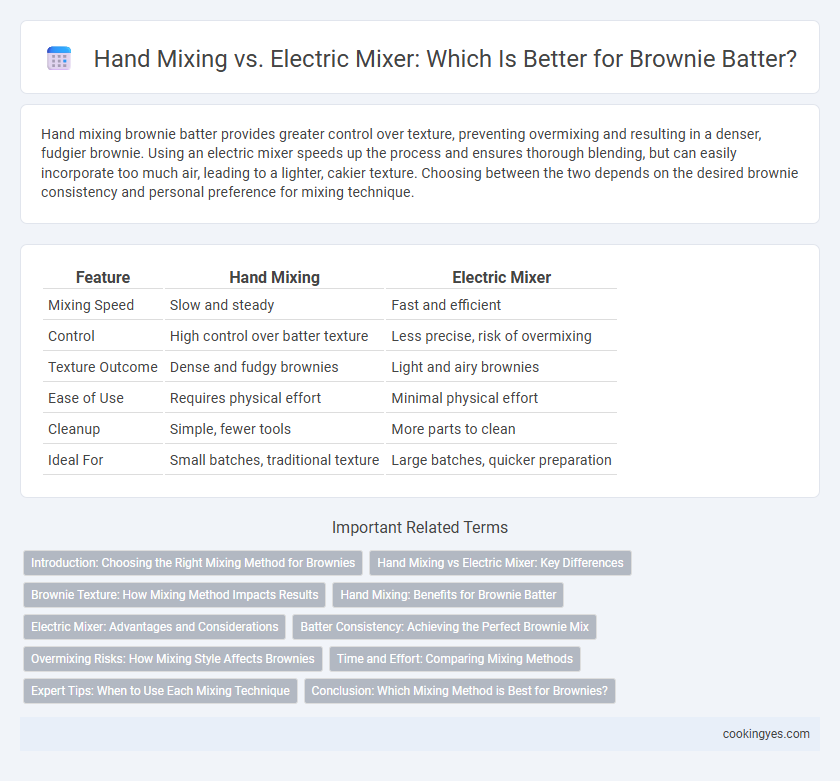Hand mixing brownie batter provides greater control over texture, preventing overmixing and resulting in a denser, fudgier brownie. Using an electric mixer speeds up the process and ensures thorough blending, but can easily incorporate too much air, leading to a lighter, cakier texture. Choosing between the two depends on the desired brownie consistency and personal preference for mixing technique.
Table of Comparison
| Feature | Hand Mixing | Electric Mixer |
|---|---|---|
| Mixing Speed | Slow and steady | Fast and efficient |
| Control | High control over batter texture | Less precise, risk of overmixing |
| Texture Outcome | Dense and fudgy brownies | Light and airy brownies |
| Ease of Use | Requires physical effort | Minimal physical effort |
| Cleanup | Simple, fewer tools | More parts to clean |
| Ideal For | Small batches, traditional texture | Large batches, quicker preparation |
Introduction: Choosing the Right Mixing Method for Brownies
Hand mixing preserves the dense and fudgy texture essential for classic brownies by preventing over-aeration of the batter. Electric mixers can introduce excess air, resulting in a lighter, cake-like consistency that some may find less desirable. Selecting the right mixing method directly influences the final crumb texture and overall indulgence of homemade brownies.
Hand Mixing vs Electric Mixer: Key Differences
Hand mixing brownie batter allows for more control and prevents overmixing, preserving the desired fudgy texture by minimizing gluten development. Electric mixers are faster and more efficient, but they can easily overbeat, incorporating excess air and resulting in a cakier, less dense brownie. Choosing between hand mixing and an electric mixer significantly affects the final brownie texture, with hand mixing preferred for denser, chewier results.
Brownie Texture: How Mixing Method Impacts Results
Hand mixing brownie batter produces a denser, fudgier texture by limiting air incorporation and protecting delicate ingredients from overmixing. Electric mixers introduce more air, resulting in a lighter, cakier brownie with a softer crumb. The chosen mixing method directly affects the final brownie texture, allowing bakers to tailor the outcome from chewy and rich to fluffy and tender.
Hand Mixing: Benefits for Brownie Batter
Hand mixing Brownie batter enhances texture control by allowing precise incorporation of ingredients, preventing overmixing and resulting in a fudgier consistency. This method ensures better integration of cocoa and chocolate, preserving the delicate crumb structure essential to rich brownies. Additionally, hand mixing reduces aeration, minimizing the risk of a cakey outcome and maintaining the dense, moist quality prized in traditional Brownies.
Electric Mixer: Advantages and Considerations
An electric mixer offers consistent blending and thorough incorporation of ingredients, ensuring a smooth and even brownie batter texture. It saves time and effort compared to hand mixing, especially beneficial for dense batters requiring extended mixing. However, overmixing with an electric mixer can lead to tough brownies due to gluten overdevelopment, so careful monitoring is essential.
Batter Consistency: Achieving the Perfect Brownie Mix
Hand mixing brownie batter allows for greater control over the texture, preventing overmixing which can lead to dense, tough brownies. An electric mixer speeds up the process but risks incorporating excess air, resulting in a lighter, cakier consistency rather than fudgy. For ideal batter consistency, gentle hand mixing ensures uniform blending of ingredients while maintaining the desired dense, moist brownie texture.
Overmixing Risks: How Mixing Style Affects Brownies
Hand mixing brownie batter minimizes the risk of overmixing, preserving the ideal dense and fudgy texture by preventing excessive gluten development. Electric mixers, while faster, can easily overbeat the batter, resulting in a cakey and dry consistency due to too much air incorporation. Choosing hand mixing ensures better control over the batter's texture, yielding rich and moist brownies.
Time and Effort: Comparing Mixing Methods
Hand mixing brownie batter offers greater control and requires minimal equipment, but it demands more physical effort and takes longer, typically 5 to 7 minutes to achieve the desired smooth consistency. An electric mixer significantly reduces mixing time to about 2 to 3 minutes, providing consistent and thorough blending while minimizing manual labor. Choosing between the two depends on whether convenience and speed or simplicity and control are prioritized during preparation.
Expert Tips: When to Use Each Mixing Technique
Hand mixing brownie batter is ideal for delicate recipes that require minimal gluten development, preserving a fudgy texture and preventing overmixing. Electric mixers excel when incorporating ingredients thoroughly and quickly, especially for recipes needing aeration or when handling large batches. Experts recommend hand mixing for dense, chewy brownies and electric mixers for lighter, cakey varieties to achieve optimal texture and consistency.
Conclusion: Which Mixing Method is Best for Brownies?
Hand mixing provides greater control over the batter's texture, ensuring a fudgy and dense brownie by preventing overmixing, which can lead to toughness. Electric mixers save time and are ideal for thoroughly combining ingredients, but they increase the risk of incorporating too much air, resulting in cakier brownies. For the perfect brownie texture, hand mixing is generally preferred to maintain optimal batter consistency and moisture.
Hand mixing vs Electric mixer for brownie batter Infographic

 cookingyes.com
cookingyes.com